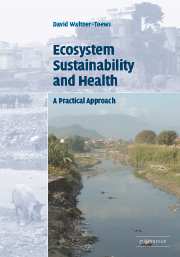Book contents
- Frontmatter
- Contents
- List of figures
- List of tables
- Introduction
- 1 Presenting complaint
- 2 The clinical examination: asking questions, getting data
- 3 Making a diagnosis: synthesizing information from data
- 4 Setting goals: where do we want to go?
- 5 Achieving goals: managing and monitoring
- 6 Responding to change: AMESH and the never-ending story
- References
- Index
6 - Responding to change: AMESH and the never-ending story
Published online by Cambridge University Press: 03 December 2009
- Frontmatter
- Contents
- List of figures
- List of tables
- Introduction
- 1 Presenting complaint
- 2 The clinical examination: asking questions, getting data
- 3 Making a diagnosis: synthesizing information from data
- 4 Setting goals: where do we want to go?
- 5 Achieving goals: managing and monitoring
- 6 Responding to change: AMESH and the never-ending story
- References
- Index
Summary
The process of assessing and creating community-based ecosystem health is never ending. Health is not so much a mirage, as Rene Dubos declared, as it is a moving target. Every person and every community and every generation must redefine what they mean by health in the context of an ever-changing ecological context. Our task is to leave as many options open to future generations as possible. This is why cultural and biological diversity are so important. They represent conserving options and the opening of new options – which is why equity and education are so important.
When an outbreak investigation is completed, and the science and the interviews and the digging around in refrigerators and simulation models and laboratory tests are done, it is the task of the investigators to take all the available information and pull it together into a meaningful narrative. In a food-borne outbreak, this story would tell how, when, and by whom the contamination took place, and set it into a larger context. The lettuce was contaminated in the kitchen two hours before being served, and so and so didn't wash his hands because the taps were placed wrongly and management put him under too much time pressure, and the staff lacked education regarding cross-contamination, etc. Similarly, promoting ecosystem health has to do with creating narratives, stories. These stories are not just entertainments. Our lives depend on them.
Ecosystem health narratives are grounded in realities that can be collectively agreed upon. Not all perspectives are equal.
- Type
- Chapter
- Information
- Ecosystem Sustainability and HealthA Practical Approach, pp. 120 - 129Publisher: Cambridge University PressPrint publication year: 2004



